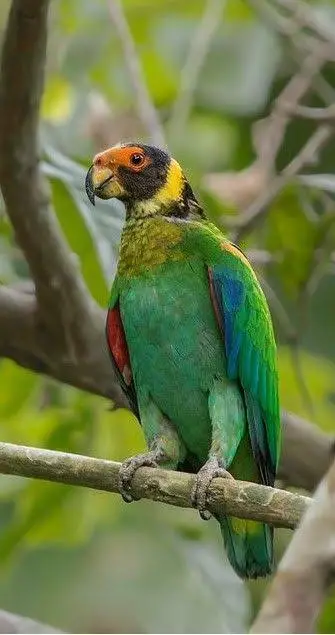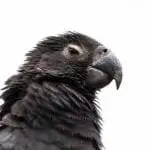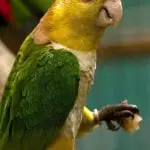Scientific Facts
| Common Name | Vulturine Parrot |
| Scientific Name | Pyrilia vulturina |
| Origin | Northeast Brazil, northwest Maranhão, Southern Venezuela and south of Amazonia in eastern Pará |
| Habitat | The vulturine parrots live in palm forests, rain forests, grasslands, scrublands, savannas, desert edges, and in some woodlands. They can also be seen in urban areas such as in the park, garden, and farmland. |
| Diet | nuts, sunflower seeds, bite-size pieces of fruits and vegetables, parrot pellets and grains |
| Size and Weight | 23 – 24 cm (9.2 – 9.5 in) length and with a weight of 120g (4.2 oz) |
| Life Span | Up to 15-20 years |
Physical Description
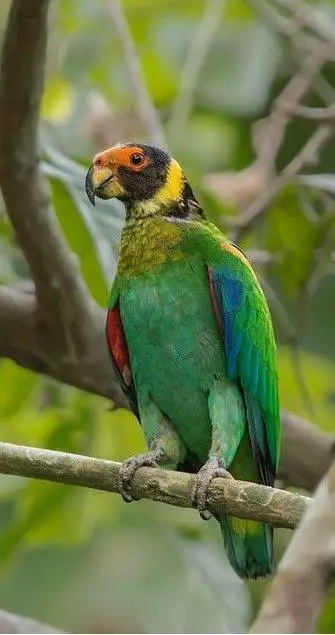
The South American parrot Gypopsitta vulturine, Bristlehead or commonly known as the vulturine parrot, is described to have a short and squarish tail that has the colors of green plumage and tinged blue. They are called the bristle head because the anterior part of their head doesn’t have feathers and that the feathers on the neck part are bristlelike. The adult and juvenile do not have significant changes in terms of their physical appearance. The adults tend to have a general color of green with hints of yellow and brown in their forehead and chin, black colorations that covers their ears, yellow or olive colorations on their upper breast, a combination of red and orange on their wings and have a black border on the nuchal collar.
Where it is Seen?
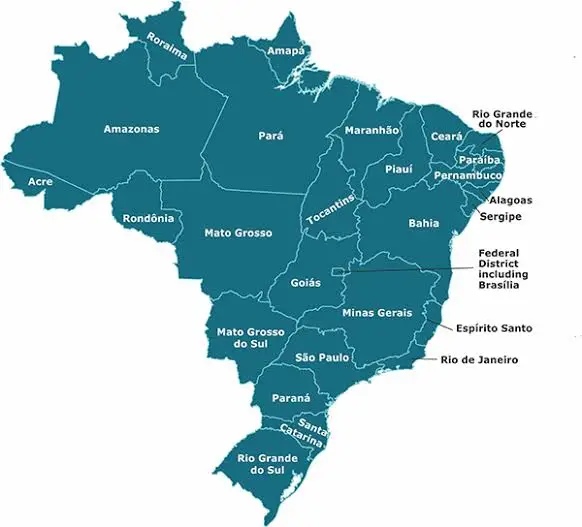
The Vulturine Parrot is regularly found in the Northeast Brazil, northwest Maranhão, Southern Venezuela and south of Amazonia in eastern Pará.
Habitat
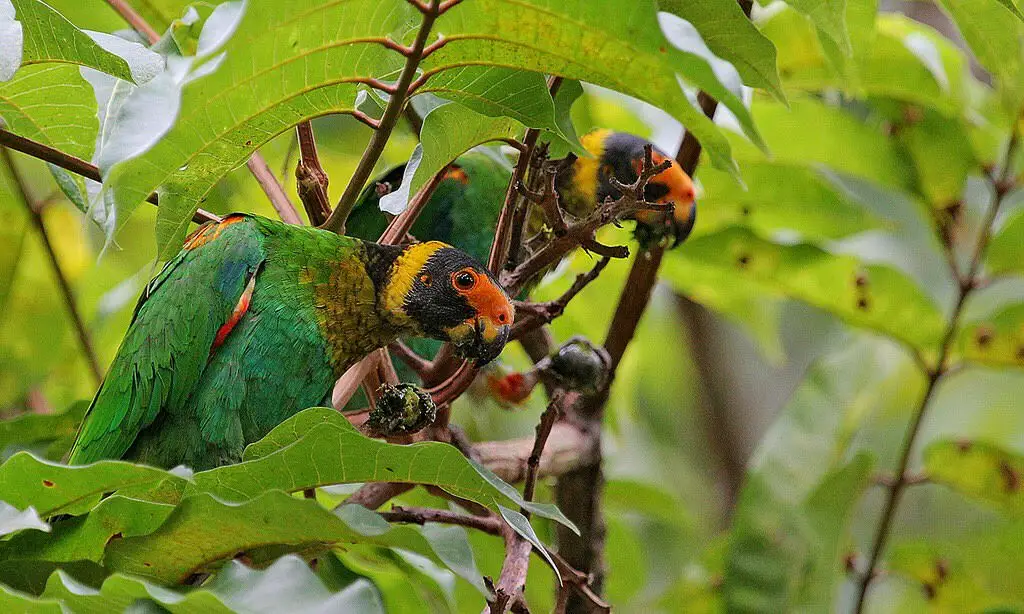
The vulturine parrots live in palm forests, rain forests, grasslands, scrublands, savannas, desert edges, and in some woodlands. They can also be seen in urban areas such as in the park, garden, and farmland.
Behavior and Temperament
Vulturine parrots are naturally friendly. They are also expressive; they show how they feel by means of body language if they are in an upright stance with their feathers that are spread out; it means that they are frightened and wary. If their feathers are loose and ruffled, it means that they are playful and happy. If they sit on one foot with feathers puffed out, it means that they are not feeling well. If they stick them out their wings as far as they can in front of another parrot, it means that they are courting and when they move their beaks up and down with their wiggling tongue, it means that they see something that they want.
Diet
The vulturine parrot feed on different kinds of seeds and berries and other types of fruits and vegetables. In captivity, they are usually given nuts, sunflower seeds, bite-size pieces of fruits and vegetables, parrot pellets and grains. They have a wide variety of healthy fruits that are also eaten by humans; that is why feeding them is not complicated due to the availability of food. They are considered omnivores, that is why you can also give them meat or chicken once in a while, especially if you are on a budget. There are foods that are toxic to them, such as chocolate, peanuts, avocados, alcohol, and caffeinated products.
Size and Weight
The Vulturine Parrot is a small-sized parrot with only 23 – 24 cm (9.2 – 9.5 in) length and with a weight of 120g (4.2 oz).
Life Span
Like other bird species, vulturine parrots tend to have a stressful and shorter life in the wild because they are more prone to different diseases or illnesses and that they are often hunted and eaten by predators. The vulturine parrot has at least 15-20 years in captivity.
Common Disease/Illnesses
- Aspergillus
This is a type of fungal infection that affects the air sacs and lungs of parrots that is usually due to the dirty and damp environment where the fungus already flourished. If your parrot is infested with this disease, it may cause difficulty in breathing due to the mucous discharge in their nostrils, audible wheezing, and their appearance seemed dull and gloomy.
- Avian Gastric Yeast (AGY) infection (megabacteriosis)
This is a contagious disease caused by yeast and bacterial infection. This disease is quite hard to distinguish during the early stages, but if your parrot is highly infected, it causes weight loss due to the inability to digest food. You may notice that your parrot has feces with undigested food, or they vomit the food intake with mucous.
- Candida virus (Thrush), or Candidiasis
This is infection is just like the effects experienced by humans when there is a yeast infection. It is evident in the parrot’s digestive tract. It can be transmitted to humans if you allow them to kiss you. Some of the symptoms of this disease are colds, mucous discharge, wheezing, and swollen eyes. This can be treated easily through antibiotics, but you may need to take your pet in a veterinary for proper admission.
- Macaw Wasting Syndrome, or Proventricular Dilatation syndrome
This is a common viral infection that leads to stomach problems. Your parrot will not have a loss in appetite, but they will have a weight loss because their food is not digested properly, evidence to this is undigested food in their droppings. If this viral infection is not attended to. Immediately, it will affect the overall immunity of the parrot that may lead to death.
- Nutritional Deficiencies
There are different manifestations of nutritional deficiency from feather loss, malformation dullness in the coloration of their feathers to changes in the behavior. The most common nutritional deficiency is Hypocalcaemia or lack of calcium. If your parrot lays eggs, and it is suffering from lack of calcium, it will be evident to the eggs that will lead to having a soft-shelled and easy to break eggs. There are specific recommended daily doses of vitamins and minerals needed for your pet, that is why you need to be aware of the food that you are giving them.
- Overweight parrot
A healthy-looking parrot os not too thin and not too fat. If your parrot is overweight, it leads to other health conditions, just like what humans experience. These health problems pertaining to nutritional deficiency and obesity-related problems. If your parrot is obese, it means that their diet is fatty and sugary, so you need to carefully check what they eat.
This Cockatiel needs to lose some weight to attain full health
- Parrot Fever, or Psittacosis
This is considered as the worst disease or illness a parrot can get because once it strikes, it may spread quickly and may cause affected parrots to die. The bacteria responsible for this is a fatal disease is the Chlamydophila psittaci.
- Polyoma
This virus directly affects baby parrots that is one of the causes of a high percentage of mortality to the youngs. When an adult parrot is infested with this viral infection, it can still be treated by means of antibiotics. Symptoms of polyoma to a baby parrot are shakiness, feather problems, and swollen stomach, while the symptoms of this viral infection to adults are more of the intestinal manifestations such as vomiting and lose fecally. To avoid this viral infection, you may opt for vaccination to be sure to prevent it.
- Psittacine Beak and Feather Disease (PBFD)
This happens when the immune system of the parrot is depressed. It is not a life-threatening disease, but it affects the overall physical appearance of the parrot because it greatly affects the formation of the feathers because the feather follicles are the ones attacked. After having a stunting and deformed feathers, it will soon drop out. If the feathers of the parrot dropped, they might be susceptible to other infections because they don’t longer have any barrier against different bacteria and infections from the environment.
- Ulcerative dermatitis
This is involved the ulcerated skin due to breakage, wounds, intestinal parasites, or diabetes.
This is a skin complaint involving ulcerated skin. It may be due to previous wounds or breakages, diabetes, or intestinal parasites. These cause uncomfortable feelings causing the parrot to further peck their skin and worsen the condition. It feels itchy and painful. When your parrot’s skin is open, it may be susceptible to bacterial or fungal infections.
Preventing Disease/Illnesses
- Clean the flooring or the cage’s substrate every other two days; you may need to wash the substrate and completely dry it before returning to the cage, or you may replace it completely. If time permits, you may need to pick up their daily droppings every day to make their surroundings always clean. Never use disinfectants that are used in the household to clean their cage because these disinfectants contain harmful chemicals that may be harmful to them; instead, you can purchase a bird-safe disinfectant to make their cage clean and sanitize always.
- Makes sure that there is no leftover food in their water and food bowl. The food and water supply should be changed daily because if they ate rotten food, it may because of digestive problems. Foods that are cooked can rot immediately since they do not distinguish a rotten food from fresh food, you may need to discard it before they eat it again.
- You may have a quarterly checkup even if your parrot seems healthy so as to prevent possible health problems. Make sure your veterinarian really specializes in birds to be sure that your pet is in good hands.
- You should have knowledge of how to detect different health problems manifestations, so if your parrot is sick, you can easily find ways on how to make them better.
Captive Breeding
There are different kinds of parrot species that have unique characteristics; that is why it is always important that before deciding to take good care of them in captivity, you have sufficient knowledge about the particular species that you will be getting. They are a wonderful pet to take into captivity, especially if you are able to provide their needs for proper housing, food, and handling. The way how you take good care of them will reflect on their health and life span. You must ensure to devote your 100% time and willingness to care and love them.
Availability-Where To Get One?
Their population is marked as vulnerable, or it means that their population is continuously decreasing, so selling them in some pet shops or physical stores might be illegal, but there are a good number of pet collectors or bird breeders that have vulturine species that breed and sell. You can find them on the Internet; however, they sell it for quite an expensive price. Be sure that you are purchasing from a legitimate parrot breeder to ensure that the parrot that they will give you is also in the pure breed and in good quality.
How To Care Parrot as a Pet?
- Housing
A cage that is shaped square or rectangular is more appropriate for vulturine parrots. Research suggests that parrots tend to have an unsafe feeling in round cages that are not equipped with corners. The cage should be large enough, especially if you are housing 2 or more parrots. Your pet is happier and healthier if they are able to move around and climb different fights of branches or bar. There should also be enough room for their food, toys, and rest areas.
The smaller parrots should occupy at least a cage that has dimensions of 24″ W x 24″ H x 24″ D and large parrots needs to stay at about 5 ft W x 6 ft H x 3½ ft D. The place where your parrot will stay is important, make sure that they can see people and where they can interact. Avoid placing them in an isolated place because they may develop aggressiveness and separation anxiety that may cause them to be stressed and ill.
- Temperature
Parrots tolerate a room temperature at about 65 to 85 degrees Fahrenheit. Avoid placing them in places that have a drastically changing temperature. If you plan to place them outside, make sure that it is the spring or summer season, temperatures below 40 degrees Fahrenheit is extremely dangerous to them that may be a cause of sudden death, there should be a thermostat if the temperature is too cold or better yet, place them inside. However, if you place them in a room that has a high temperature, make sure that there is sufficient air circulation.
- Feeding
In captivity, it is advisable to give your parrot a shifting or varying diet to ensure that they also get nutritional value from different sources. They are usually given birdseed, and pellet mixes, these types of food for them are enriched with minerals and nutrients but it is still best to give them real and fresh fruits and vegetables but be cautious in giving them food because there are some foods that are considered toxic in their body that can be fatal such as avocado, onions, caffeine, chocolate, raw and dry beans, and alcohol. Some parrots that were given these types of food experienced cardiac arrest and sudden death. The healthy options for them are bananas, apples, carrots, berries, grapes, and some cooked items such as green beans, mashed squash, peas, etc. Baby parrots should be given small amounts of food but in a regular pattern since they have a faster metabolism than adults.
- Water
The water container in your parrot’s cage does not only serve as drinking water, but it also serves as a place where they bathe in that is why it is important to always give them fresh and clean water every day. There is a lot of information to add vitamin supplements in their drinking water, but this is not advisable since these parrots are not a regular drinker, the supplements that you add will just be wasted. It is still advisable to add vitamin supplements into their food to ensure that it will be directly consumed.
Facts in Handling your Vulturine Parrot?
- Introduce yourself to your parrot by means of approaching their cage quietly and slowly. If you sense that they are shy or fearful, making eye contact with them is helpful. If they show signs of aggressiveness as you go towards their cage, do not approach further but instead, do this regularly, when they often see you, they get accustomed with your presence until they no longer show signs of uneasiness.
- If you are planning to train your parrot, giving a treat is an important factor as their reward. For you determine their favorite, give them a variety of food in one meal, the type of food that they will eat first is probably their favorite, so in regular feeding, don’t give them their favorite because this will serve as their treat.
- Vulturine parrots like to be touched and pet making them easy to tame. You would know that your parrot is comfortable with you if it is no longer making any attempts to bite you if they are in your arms.
- Parrots want to get the attention that is why talking to them will make their emotional health healthier and happier.
- Toys in their cage can effectively ease their boredom, and it stimulates their mental ability. The choice of food given to them should have a variety of colors and textures.
Conservation Status
They are marked in the IUCN Red List as vulnerable, which has slowly degraded the population in the wild due to several reasons such as illegal hunting, destruction of their habitat, and due climate change. There were different efforts from private sectors to ensure that their population will not fall into the endangered category. Those who want to take it into captivity are encouraged to breed because taking them from the wild is almost not permissible.
FAQ Section
How can I tame my vulturine parrot?
They are being trained through the use of a reward-based training method. The common reward that is used in training them is through the use of food and toys. Use a reward-based training method involving a clicker. First, find their favorite foods, then get them to associate getting a treat with the sound of the clicker. Then click when they perform a behavior you want and reward them. Then they will be eager ways to make your click in order to get a reward.
What is the personality of a vulturine parrot?
Vulturine parrots are curious, playful, intelligent, and affectionate. They are natural performers because they have the ability to naturally perform like sing and talk as long as they are trained correctly.
Are vulturine parrots a good pet?
Aside from its astonishing feather colors, they are known for their intelligence and easy to care characteristics. If you meet their standards when it comes to their captive home, they can live-long healthily and happy-making them a good pet.
What is the food for baby parrots?
In captivity, you can give them baby bird food found on some local pet stores. It is not yet advisable to give them food that is given to adults because the baby parrot may still have a hard time digesting it.
How do I know when the vulturine parrot should stop eating?
Vulturine parrots would not stop eating as long as there is food in their bowl; that is why you need to know the appropriate amount of food that you should only give them. If, in any case, they don’t eat even though there is food in their bowl, you may need to consult a veterinarian because there is a possibility that there is a problem with their health.

